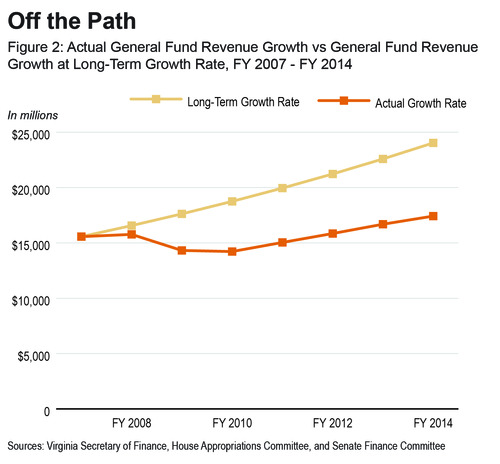July 19, 2013
Taking the Long View
Virginia closed the books on its 2013 budget year last month with its fourth consecutive revenue surplus. But a surplus just means that we collected more money than we were expecting. What it doesn’t mean is that we’ve met our needs and have money to spare. While it’s certainly good news that revenue growth is ticking back up to normal levels after a deep recession and a slow recovery, Virginia still faces some serious challenges.
A key driver of Virginia’s recent surpluses has been lawmakers’ reliance on conservative revenue estimates to build the budget. As shown in Figure 1, Virginia’s actual revenue growth has exceeded forecasted growth each year since 2010. By building a budget on very cautious revenue assumptions, Virginia has made it that much easier to hit a “surplus” by year end.

Even though revenue growth is exceeding expectations, there’s no denying how severely the recession set Virginia back. Figure 2 shows Virginia’s actual revenue collections compared to what they would have been under normal growth rates.

Over the previous three decades, Virginia’s general fund grew at an average of about 6.4 percent per year; slightly higher than the growth we’ve experienced the past three years. If Virginia had maintained the normal pattern of growth instead of seeing revenues tank when the recession began in 2007, the commonwealth would have had an extra $5.9 billion in 2013 to invest in education, health care, and the other foundations of a robust economy.
Instead, we have failed to invest adequately in key drivers of growth like education. Despite a growing population and rising costs, state investments in creating a skilled workforce have fallen. For the budget year that just ended, for example, investment in K-12 education was down 8 percent— about $479 million—compared to before the recession. State support for higher education – which does not include tuition and fees paid by students – was also down 8 percent. On top of that, state investments in university classrooms, research institutions, and other infrastructure that will serve future generations fell to $20 million from $900 million.
The bottom line: Although Virginia’s revenue outlook is improving, past budget cuts continue to hold us back and underlying problems with the way we raise resources put future prosperity at risk. Promoting real, long-term growth requires a modern revenue system that generates enough resources to invest in the things that create jobs, build a strong economy, and contribute to a high quality of life across the commonwealth.
-Sara Okos, Policy Director
